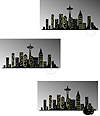| ISO 9000 | ISO 14000 |
 GMP Consulting |
Combining LensesAs you experimented with DRAW’s lenses, you may have noticed for yourself that you can overlay one lens on another. For example, you might want to both magnify and brighten an object underneath a lens. When you apply a new lens, you replace any existing lens; they are not added together. However, you can stack lens objects on top of one another. Make a quick copy of a lens object, which effectively duplicates the lens effect. Then change to a different lens effect, and you create a compound lens effect.
Learning to Use the LensesHaving experimented with the effects produced by each lens type, your head might already be swimming with ideas of how to use them. Here are a few. Tinted Grayscale for Cheap ColorIf you want to add a bit of color or take away color, the Tinted Grayscale lens is your answer. We mentioned earlier that you can import a full-color photograph or drawing and apply a Tinted Grayscale lens to it, to convert it to grayscale. You can also colorize a black-and-white image by adding a Tinted Grayscale lens. Despite this lens’s name, you can choose any color for it, making it easy and affordable to add some color to a project. Heat MapLike Tinted Grayscale, Heat Map is most effective when used with grayscale photographs. Try importing a photo and applying this lens. The result is an effect that has become very popular in Generation X publications. If you are planning to publish a magazine dedicated to heavy-metal music, this is definitely the lens for you. Using Brighten to Create Text BackdropsAnother popular technique used in many publications is to brighten or “wash out” part of an image to place text over it. The Brighten lens makes it easy to accomplish this, as Figure 17.7 shows.
The Miracle of Interactive TransparencyOur lead author relates a recent experience at a California seminar:
Here it is version 9, and we suspect that many of you are still just getting to know this incredible tool. It does not produce as many effects as Lens, concentrating instead on the one lens effect, transparency, used by most users. As an interactive tool, it offers several usability advantages over the docker; and as a more refined tool, it offers functionality that Lens can’t touch. Interactive Transparency, the tenth icon in the toolbox, operates like all of the other interactive tools that you have read about:
To use Interactive Transparency effectively, remember the following three points. No More Docking and ApplyingYou can dispense with the Lens docker for standard transparency effects, as Interactive Transparency works straight off of its property bar. No more having to fetch the docker, and no more incessant clicking of an Apply button. Just Like Filling an ObjectInteractive Transparency works just like the Fill tool in its range of possibilities. But instead of applying a color, shade, or pattern to an object, you are applying a degree of transparency to it. (Technically, the same engine is used: when you apply transparency to an object on top, DRAW creates the effect by changing the fill pattern of any objects underneath.) Forget the nerdspeak; the essential point to take away is that you can create transparencies that are themselves fountains, patterns, or textures. The latter two are risky and carry a very high ugliness quotient, but fountain transparencies are very useful and potentially dramatic. To that end, we promised a return to two graphics that we created in earlier chapters. In Chapter 10, we introduced you to text wrapping with a nice, clean graphic of an article wrapping around a globe. Figure 10.1 shows the image, made a bit more dynamic by the presence of the transparent text. We set the text in Futura ExtraBlack, filled it white, and stretched it out to fit the space. Then we used the Interactive Transparency tool to apply a “fountain transparency” to it—the degree of transparency changes gradually, like the degree of color of a fountain fill.
|
||||||||||||||||||
|
|


